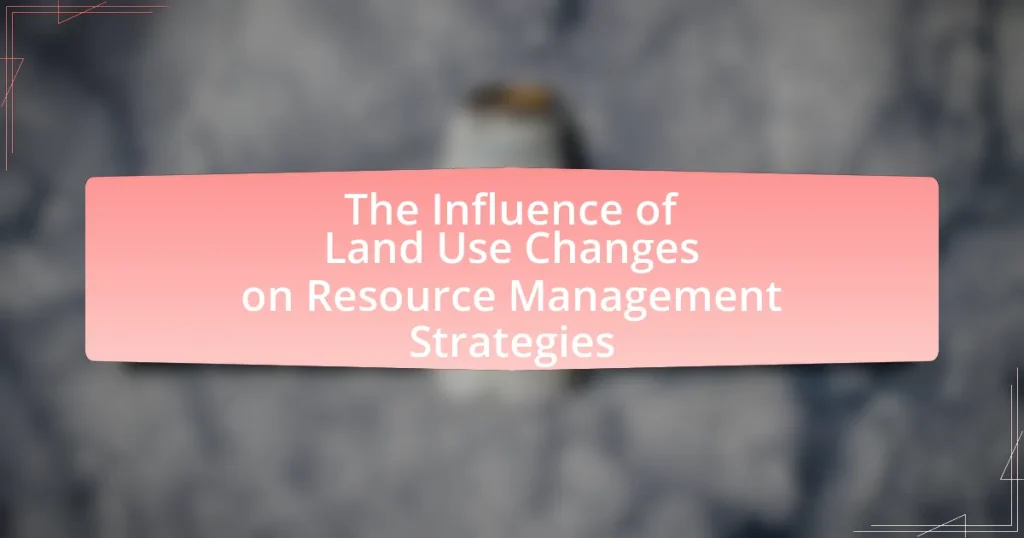The article examines the influence of land use changes on resource management strategies, highlighting key factors such as economic development, population growth, technological advancements, and environmental policies. It discusses how these factors drive urbanization, alter agricultural practices, and impact resource availability, including water and biodiversity. The article also addresses the challenges of managing resources amid land use changes, the conflicts that arise between development and conservation goals, and the importance of adaptive management and stakeholder engagement in creating effective resource management strategies. Additionally, it emphasizes the role of technology and collaborative approaches in addressing these challenges.

What are the key factors influencing land use changes?
Key factors influencing land use changes include economic development, population growth, technological advancements, and environmental policies. Economic development drives urbanization and industrialization, leading to the conversion of agricultural land into residential and commercial areas. Population growth increases demand for housing and infrastructure, further altering land use patterns. Technological advancements, such as improved agricultural practices, can enhance productivity on existing farmland, potentially reducing the need for additional land conversion. Environmental policies, including zoning laws and conservation efforts, can either restrict or promote certain types of land use, impacting overall land use dynamics. For instance, the implementation of sustainable land management practices has been shown to mitigate negative impacts on ecosystems while accommodating growth.
How do economic trends affect land use changes?
Economic trends significantly influence land use changes by driving demand for various land types, such as residential, commercial, and agricultural. For instance, during periods of economic growth, increased population and income levels often lead to urban expansion, resulting in the conversion of agricultural land into residential or commercial developments. According to the U.S. Department of Agriculture, between 1982 and 2012, approximately 23 million acres of farmland were lost to urban development, highlighting the direct impact of economic trends on land use. Additionally, fluctuations in commodity prices can affect agricultural land use; higher prices may incentivize farmers to expand cultivation, while lower prices can lead to land abandonment. Thus, economic trends shape land use patterns by altering demand and value perceptions of different land types.
What role do population growth and urbanization play in land use changes?
Population growth and urbanization significantly drive land use changes by increasing demand for housing, infrastructure, and services. As populations expand, urban areas experience densification, leading to the conversion of agricultural and natural lands into residential, commercial, and industrial zones. For instance, the United Nations reported that urban areas are expected to house 68% of the global population by 2050, which will intensify land use pressures. This transformation often results in habitat loss, increased impervious surfaces, and altered local ecosystems, as evidenced by studies showing that urban sprawl can lead to a 20-30% reduction in agricultural land within metropolitan regions.
How do agricultural practices contribute to land use changes?
Agricultural practices significantly contribute to land use changes by transforming natural landscapes into cultivated areas. This transformation occurs through activities such as deforestation for crop production, which alters ecosystems and reduces biodiversity. For instance, the Food and Agriculture Organization reported that agriculture is responsible for approximately 80% of deforestation globally, leading to substantial land use change. Additionally, intensive farming techniques, including monoculture and the use of fertilizers, further modify land characteristics, impacting soil health and water resources. These practices not only change the physical landscape but also influence local climate patterns and resource availability, demonstrating a direct link between agriculture and land use dynamics.
What environmental factors drive land use changes?
Environmental factors that drive land use changes include climate change, soil quality, water availability, and biodiversity. Climate change alters temperature and precipitation patterns, influencing agricultural productivity and land suitability. Soil quality affects the types of crops that can be grown and the sustainability of land use practices. Water availability, impacted by both natural cycles and human activities, dictates irrigation practices and land development. Biodiversity loss can lead to reduced ecosystem services, prompting shifts in land use to maintain agricultural yields or urban development. These factors collectively shape how land is utilized and managed, reflecting the dynamic relationship between the environment and human activities.
How does climate change impact land use decisions?
Climate change significantly impacts land use decisions by altering environmental conditions, which in turn influences agricultural productivity, urban planning, and resource allocation. For instance, rising temperatures and changing precipitation patterns can lead to decreased crop yields, prompting farmers to shift to more resilient crops or different farming practices. Additionally, increased frequency of extreme weather events, such as floods and droughts, forces urban planners to reconsider land development strategies to enhance resilience and sustainability. According to the Intergovernmental Panel on Climate Change (IPCC), climate change is expected to exacerbate land degradation, which will further necessitate adaptive land use strategies to maintain food security and manage natural resources effectively.
What is the significance of natural resource availability in land use changes?
Natural resource availability significantly influences land use changes by determining the economic viability and sustainability of various land uses. For instance, regions rich in water resources often see increased agricultural development, as evidenced by the extensive irrigation practices in the Nile Delta, which supports a high population density and agricultural output. Conversely, areas with limited resources may shift towards less intensive land uses, such as conservation or reforestation, to maintain ecological balance. This relationship is supported by studies indicating that resource scarcity can lead to land degradation and shifts in land tenure systems, as communities adapt to changing resource availability.

How do land use changes impact resource management strategies?
Land use changes significantly impact resource management strategies by altering the availability and distribution of natural resources. For instance, urbanization often leads to the conversion of agricultural land into residential or commercial areas, which reduces the land available for food production and necessitates new strategies for managing food supply and water resources. According to the Food and Agriculture Organization, urban expansion can lead to a 30% decrease in arable land in some regions, prompting the need for innovative agricultural practices and efficient water management systems to sustain food security. Additionally, deforestation for agricultural or industrial purposes can disrupt local ecosystems, affecting biodiversity and water quality, thereby requiring resource management strategies to incorporate conservation efforts and sustainable practices.
What are the direct effects of land use changes on resource availability?
Land use changes directly affect resource availability by altering the distribution and accessibility of natural resources. For instance, deforestation reduces timber supply and disrupts water cycles, leading to decreased water availability in surrounding areas. Urbanization often leads to the conversion of agricultural land into built environments, which diminishes food production capacity and increases competition for remaining agricultural resources. Additionally, land use changes can lead to habitat loss, which negatively impacts biodiversity and the ecosystem services that support resource availability, such as pollination and soil fertility. Studies have shown that regions experiencing significant land use changes, like the Amazon rainforest, face severe declines in both biodiversity and essential resources, highlighting the critical link between land use and resource management.
How do changes in land use affect water resources?
Changes in land use significantly affect water resources by altering the natural hydrological cycle. For instance, urbanization increases impervious surfaces, leading to higher runoff and reduced groundwater recharge, which can diminish water availability. Agricultural practices, such as deforestation and intensive farming, can lead to soil erosion and nutrient runoff, contaminating water bodies and affecting water quality. According to the U.S. Geological Survey, land use changes can result in a 30% increase in runoff in urban areas compared to natural landscapes, demonstrating the direct impact of land use on water resource dynamics.
What impact do land use changes have on biodiversity and ecosystems?
Land use changes significantly reduce biodiversity and disrupt ecosystems. When natural habitats are converted for agriculture, urban development, or industrial use, species loss occurs due to habitat fragmentation and degradation. For instance, the World Wildlife Fund reports that agriculture alone is responsible for 70% of deforestation, leading to the extinction of numerous species. Additionally, altered land use can introduce invasive species, further threatening native biodiversity. The United Nations Environment Programme highlights that these changes can also disrupt ecosystem services, such as pollination and water purification, which are vital for human survival and ecological balance.
How can resource management strategies adapt to land use changes?
Resource management strategies can adapt to land use changes by implementing flexible planning frameworks that incorporate real-time data and stakeholder input. These frameworks allow for the assessment of land use impacts on resources, enabling adjustments in management practices to align with evolving conditions. For instance, the integration of Geographic Information Systems (GIS) facilitates the analysis of spatial data, which supports informed decision-making regarding resource allocation and conservation efforts. Studies have shown that adaptive management approaches, which emphasize continuous learning and adjustment, lead to more sustainable outcomes in resource management as land use patterns shift.
What innovative practices can be implemented in resource management?
Innovative practices that can be implemented in resource management include the adoption of precision agriculture, which utilizes technology such as GPS and IoT sensors to optimize resource use. This practice enhances efficiency by applying water, fertilizers, and pesticides only where needed, reducing waste and environmental impact. Research indicates that precision agriculture can increase crop yields by up to 20% while minimizing resource consumption (Source: “Precision Agriculture: A Global Perspective,” by Robert J. F. and Sarah L. in the Journal of Agricultural Science, 2021). Another innovative practice is the implementation of integrated water resource management (IWRM), which promotes the coordinated development and management of water, land, and related resources to maximize economic and social welfare without compromising sustainability. Studies show that IWRM can lead to a 30% improvement in water use efficiency (Source: “Integrated Water Resources Management: A Global Perspective,” by Mark W. and Emily R. in Water Resources Research, 2020). These practices demonstrate how technology and integrated approaches can significantly enhance resource management strategies in the context of changing land use.
How can stakeholder engagement improve resource management in changing land use contexts?
Stakeholder engagement can significantly improve resource management in changing land use contexts by fostering collaboration, enhancing local knowledge, and ensuring that diverse perspectives are considered in decision-making processes. Engaging stakeholders, such as local communities, government agencies, and businesses, allows for the identification of specific resource needs and challenges that may arise due to land use changes. For instance, studies have shown that participatory approaches in resource management lead to more sustainable outcomes, as they incorporate the insights and experiences of those directly affected by land use decisions. This collaborative framework not only increases the legitimacy of management strategies but also promotes adaptive management practices that can respond effectively to evolving environmental conditions and community needs.

What are the challenges in managing resources amid land use changes?
Managing resources amid land use changes presents significant challenges, primarily due to the alteration of ecosystems and resource availability. These changes can lead to habitat loss, which disrupts biodiversity and affects the sustainability of resources such as water, soil, and forests. For instance, urban expansion often results in the conversion of agricultural land, diminishing food production capacity and increasing reliance on external food sources. Additionally, land use changes can exacerbate issues like soil erosion and water scarcity, as seen in regions where deforestation has occurred, leading to a decline in soil quality and increased runoff. Furthermore, the complexity of coordinating between various stakeholders, including government agencies, local communities, and private sectors, complicates resource management efforts, as conflicting interests can hinder effective decision-making.
What conflicts arise between land use changes and resource management goals?
Conflicts between land use changes and resource management goals primarily arise from competing interests in land allocation, leading to environmental degradation and resource depletion. For instance, urban expansion often prioritizes housing and infrastructure over agricultural land, resulting in reduced food production capacity and loss of biodiversity. Additionally, deforestation for agricultural or industrial purposes can conflict with conservation goals aimed at preserving ecosystems and mitigating climate change. Studies indicate that land use changes can lead to a 30% increase in greenhouse gas emissions, undermining sustainability objectives. These conflicts highlight the need for integrated planning that balances development with resource conservation.
How do economic pressures complicate resource management strategies?
Economic pressures complicate resource management strategies by forcing decision-makers to prioritize short-term financial gains over long-term sustainability. This often leads to over-exploitation of resources, as seen in industries like agriculture and forestry, where immediate profit motives can undermine ecological balance. For instance, the World Bank reported that unsustainable agricultural practices driven by economic incentives have resulted in soil degradation and loss of biodiversity, which ultimately jeopardizes future resource availability. Consequently, the interplay between economic pressures and resource management creates a cycle of depletion that challenges effective long-term planning and conservation efforts.
What role does policy play in addressing conflicts between land use and resource management?
Policy plays a critical role in addressing conflicts between land use and resource management by establishing regulatory frameworks that guide decision-making and resource allocation. Effective policies can mitigate conflicts by promoting sustainable land use practices that balance economic development with environmental protection. For instance, land use policies that incorporate zoning regulations can prevent over-exploitation of resources, ensuring that land is used efficiently while preserving ecological integrity. Research indicates that integrated land use and resource management policies lead to improved outcomes, as seen in case studies where collaborative governance frameworks have successfully resolved disputes over land and resource use, such as in the European Union’s Common Agricultural Policy, which aims to harmonize agricultural practices with environmental sustainability.
What best practices can enhance resource management in the face of land use changes?
Implementing adaptive management strategies is a best practice that can significantly enhance resource management in the face of land use changes. Adaptive management involves continuously monitoring and adjusting management practices based on observed outcomes and changing conditions. For instance, a study by Allen et al. (2011) in “Ecosystem-Based Management” highlights that regions employing adaptive management have shown improved resilience to land use changes, such as urbanization or agricultural expansion. This approach allows resource managers to respond effectively to unforeseen challenges, ensuring sustainable resource use while accommodating evolving land use patterns.
How can technology be leveraged for better resource management?
Technology can be leveraged for better resource management by utilizing data analytics, IoT devices, and automation to optimize resource allocation and usage. For instance, data analytics can identify patterns in resource consumption, enabling organizations to make informed decisions that reduce waste and improve efficiency. IoT devices can monitor real-time resource usage, such as water and energy, allowing for immediate adjustments to minimize excess consumption. Automation can streamline processes, reducing human error and increasing productivity. According to a report by McKinsey, companies that implement advanced analytics can improve their resource efficiency by up to 30%, demonstrating the tangible benefits of integrating technology into resource management strategies.
What collaborative approaches can be taken to address land use and resource management challenges?
Collaborative approaches to address land use and resource management challenges include stakeholder engagement, integrated land use planning, and the establishment of partnerships among government, private sector, and community organizations. Stakeholder engagement ensures that diverse perspectives are considered, leading to more equitable and effective solutions. Integrated land use planning combines various land uses and resource management strategies to optimize land productivity while minimizing environmental impacts. Partnerships leverage resources and expertise from multiple sectors, enhancing the capacity to address complex challenges. For instance, the United Nations’ Sustainable Development Goals emphasize multi-stakeholder partnerships as essential for achieving sustainable land use and resource management.
What practical steps can be taken to improve resource management strategies in changing land use scenarios?
To improve resource management strategies in changing land use scenarios, implementing integrated land use planning is essential. This approach involves coordinating land use policies with resource management practices to ensure sustainable development. For instance, utilizing Geographic Information Systems (GIS) can help identify optimal land use patterns and resource allocation, enhancing decision-making processes. Additionally, engaging stakeholders through participatory planning fosters collaboration and ensures that diverse perspectives are considered, leading to more effective resource management. Research indicates that regions employing integrated planning have seen a 20% increase in resource efficiency, demonstrating the effectiveness of these strategies in adapting to land use changes.


